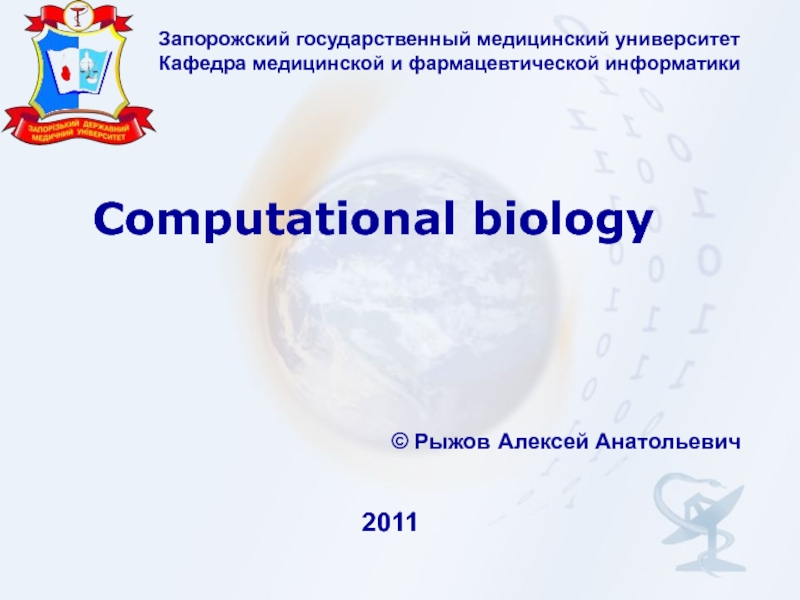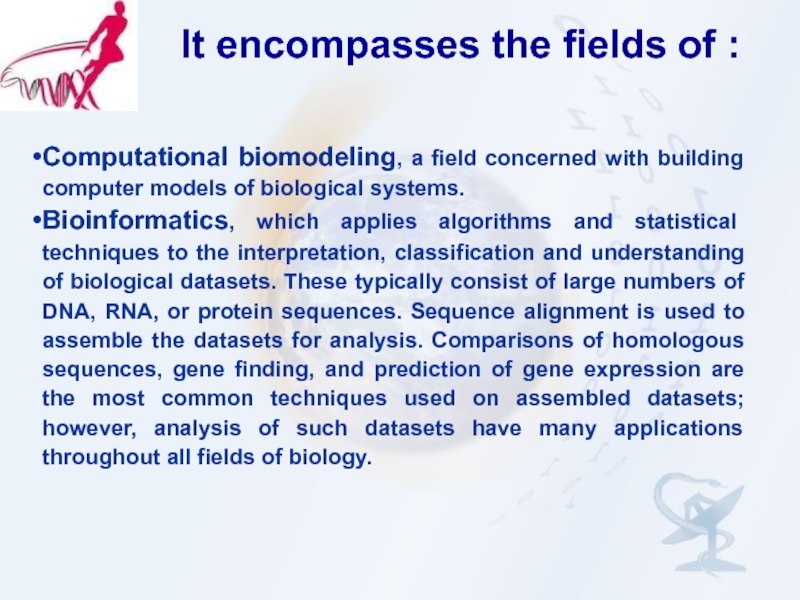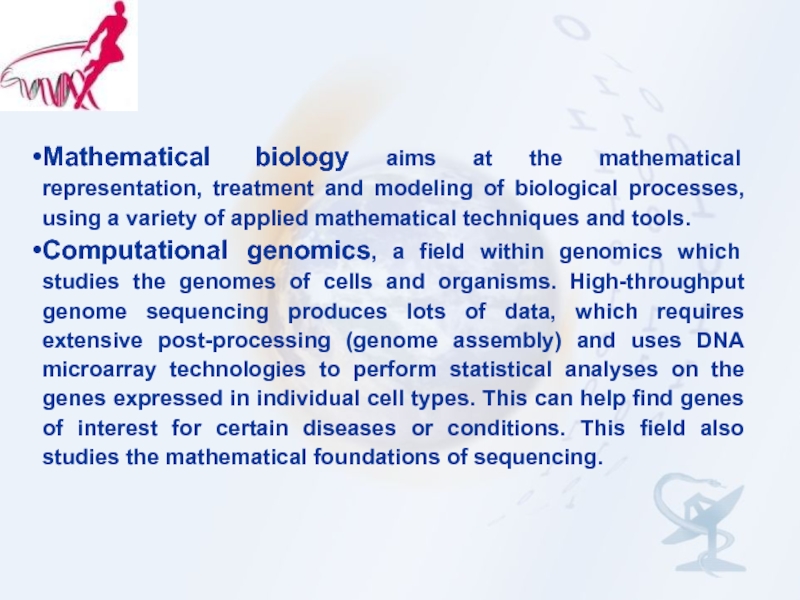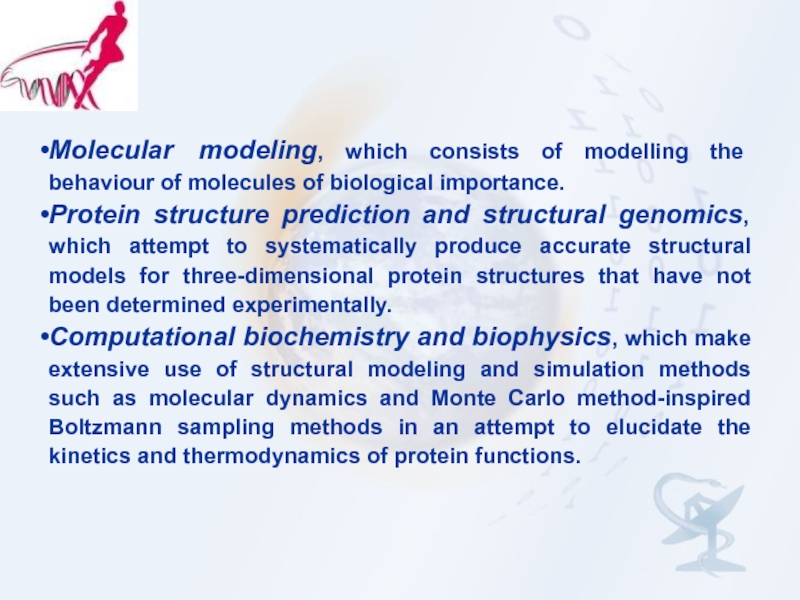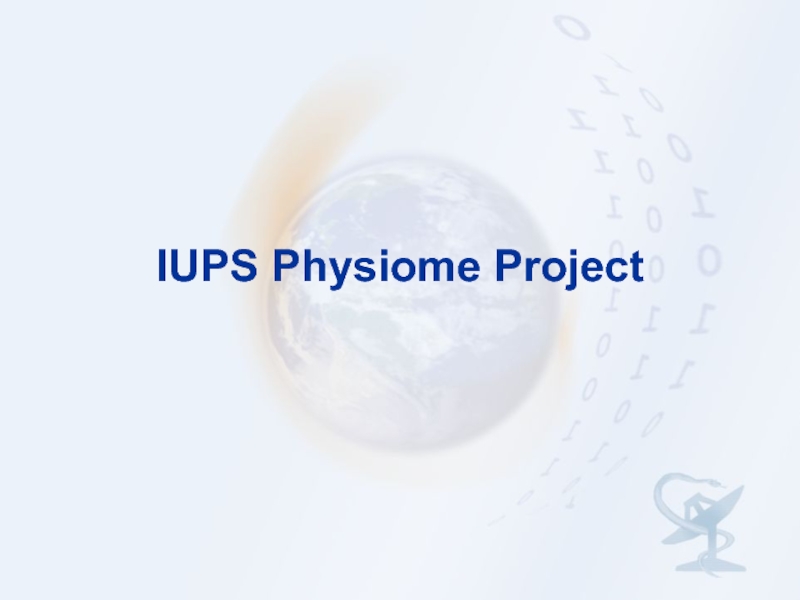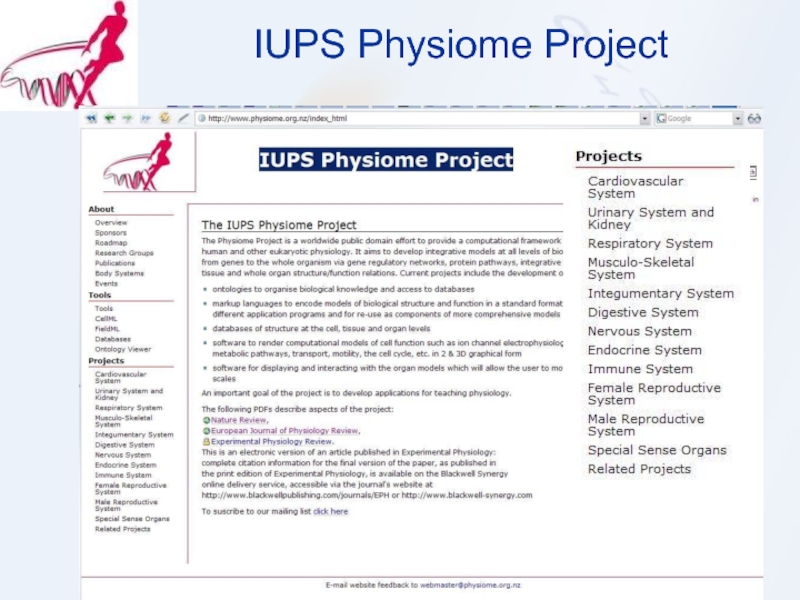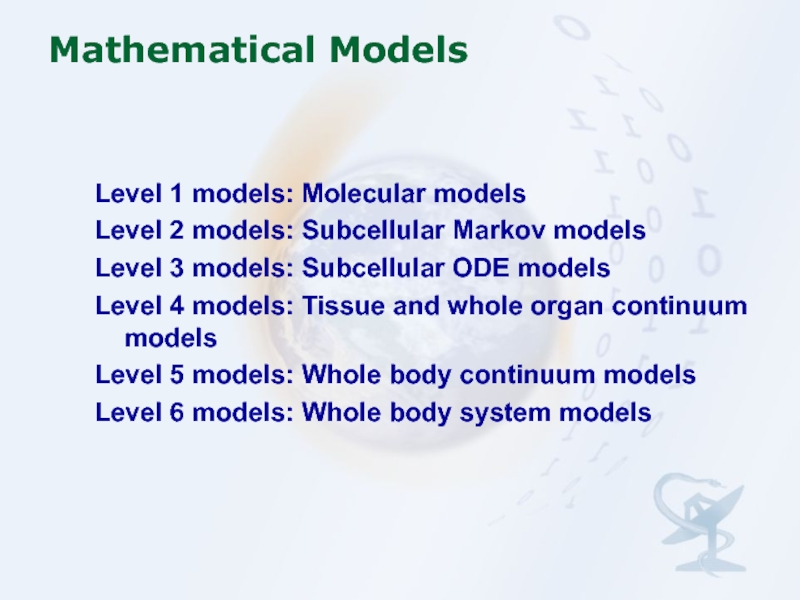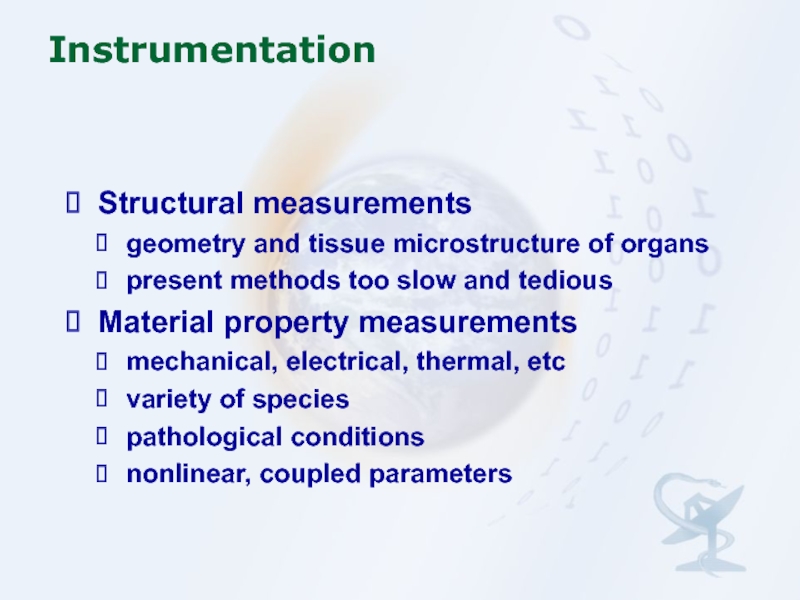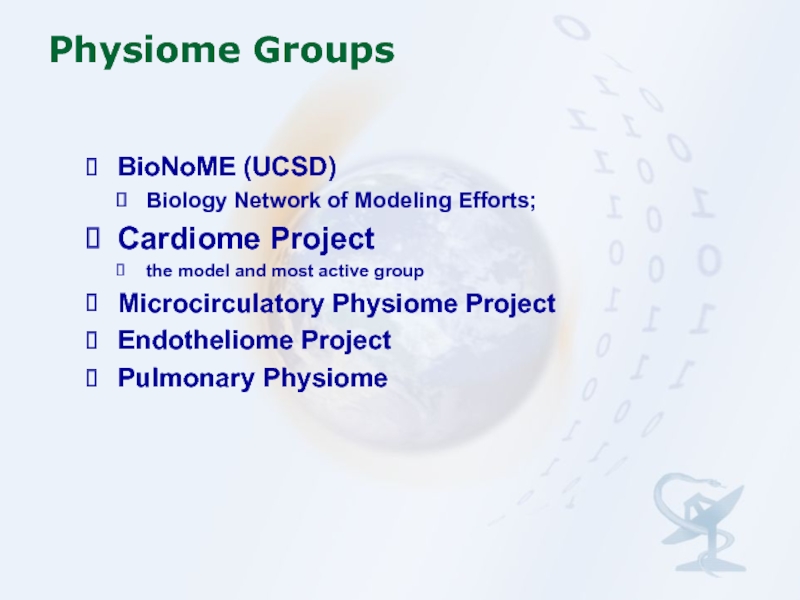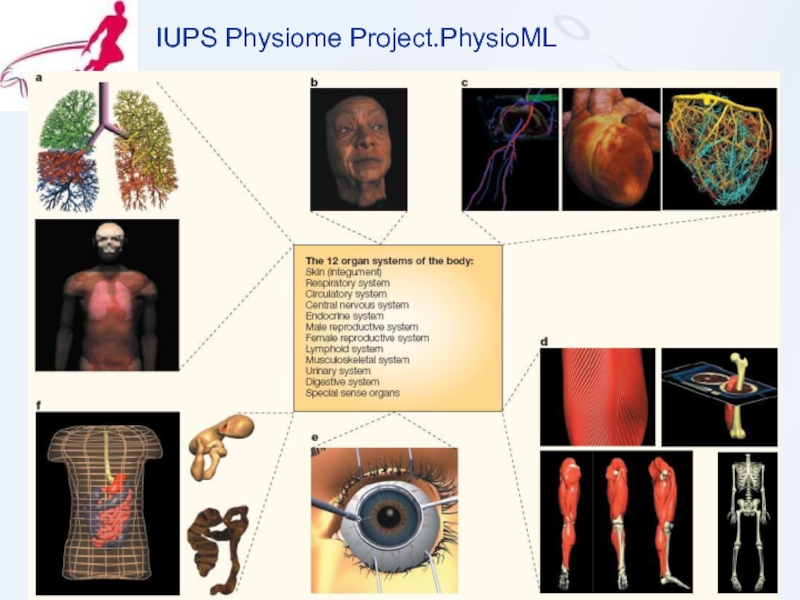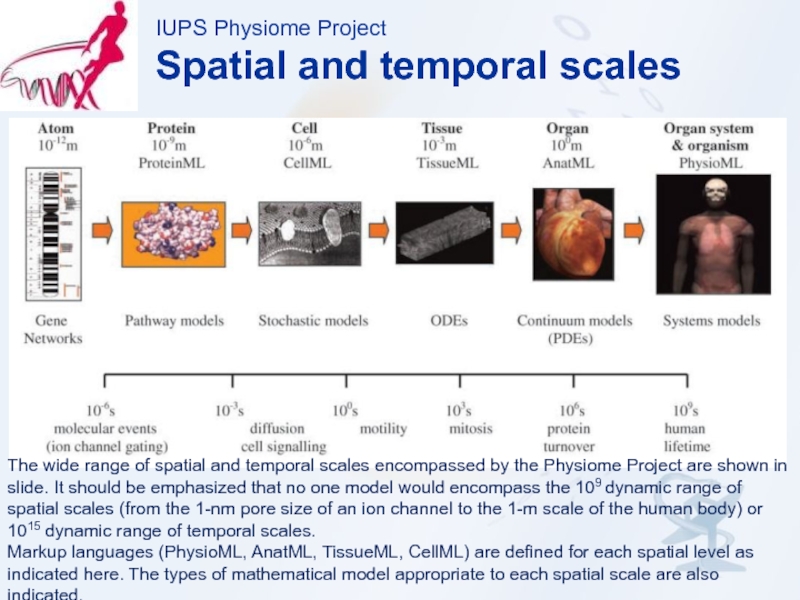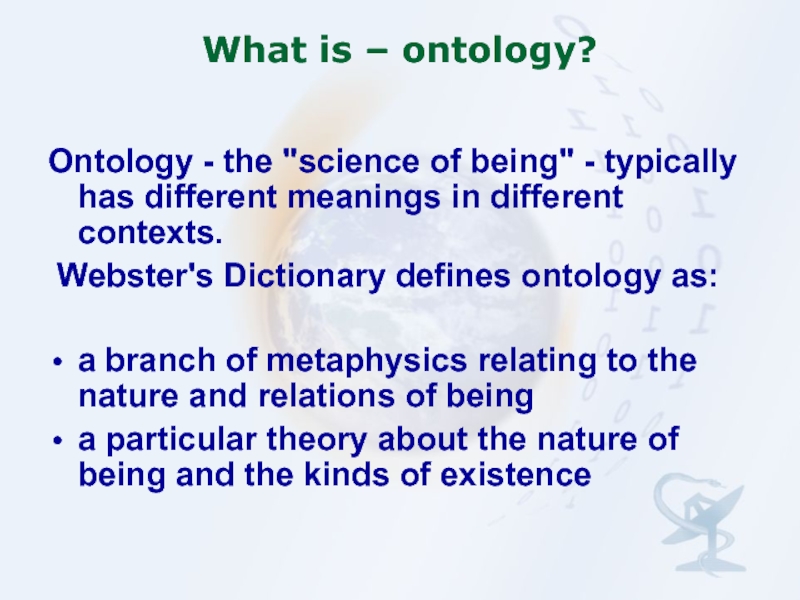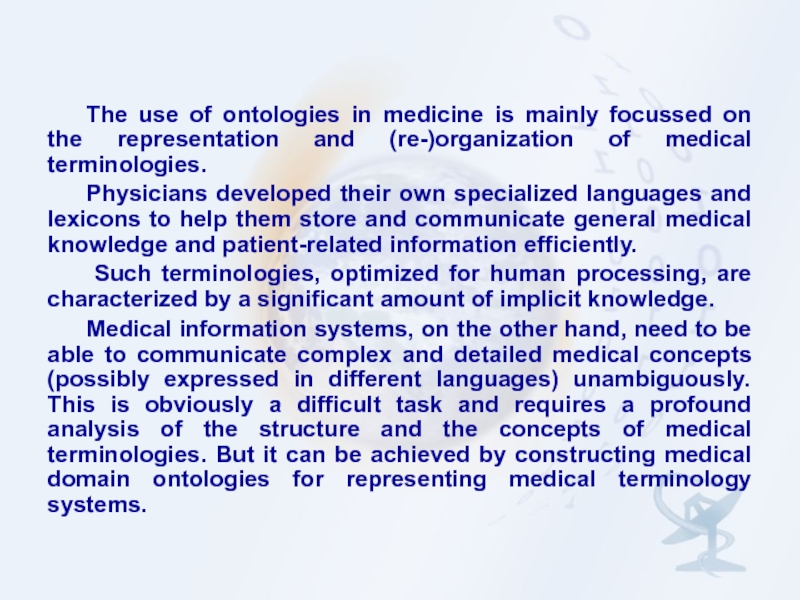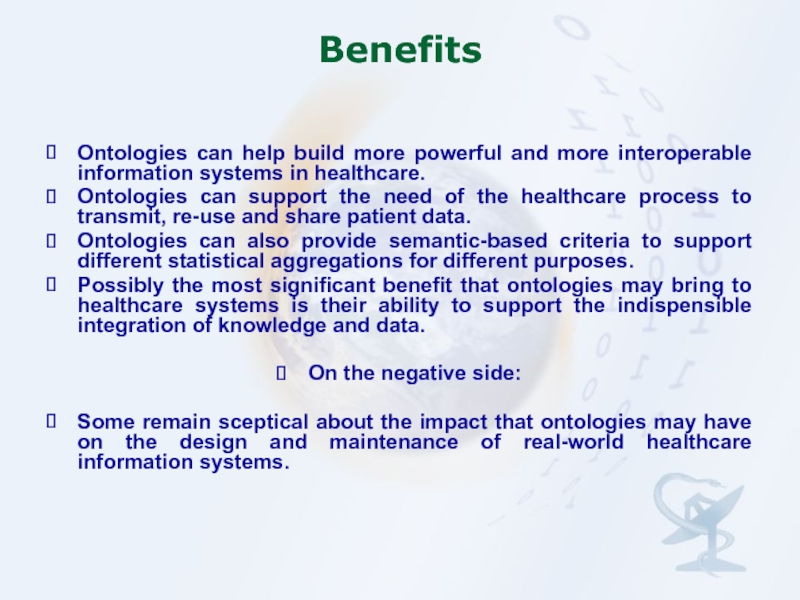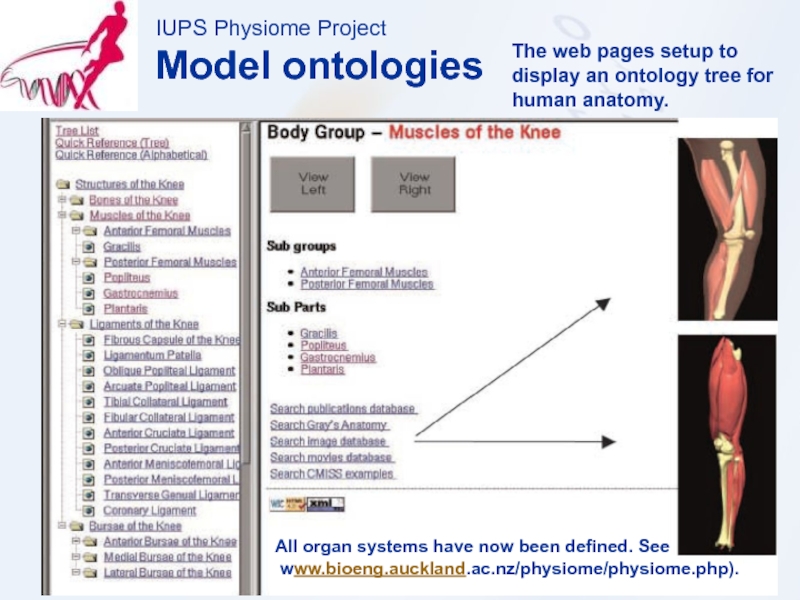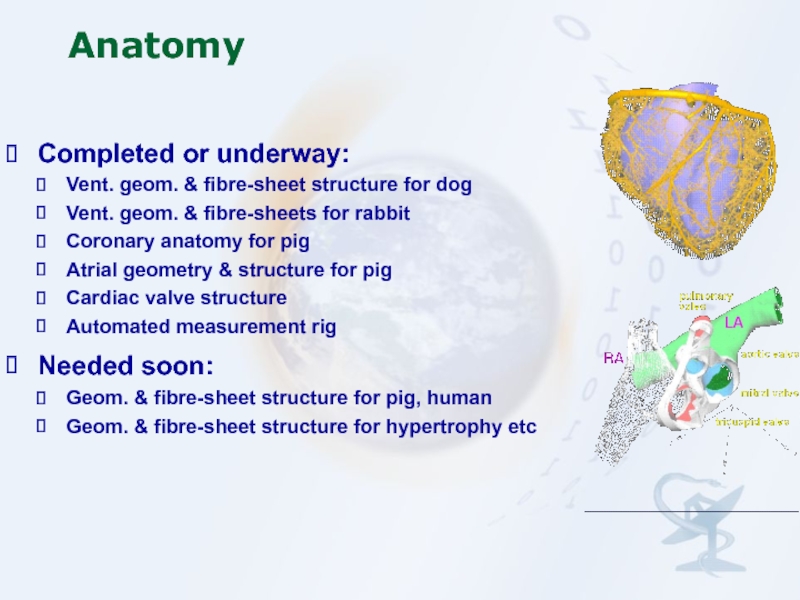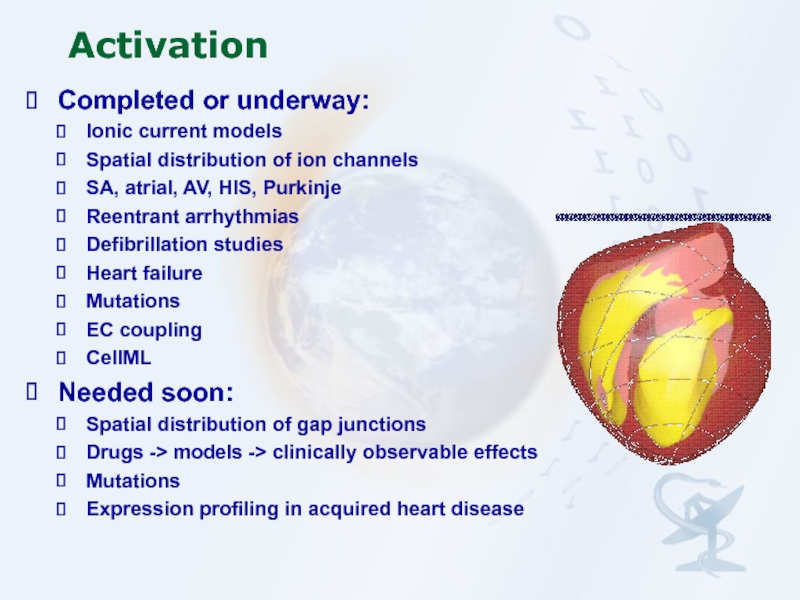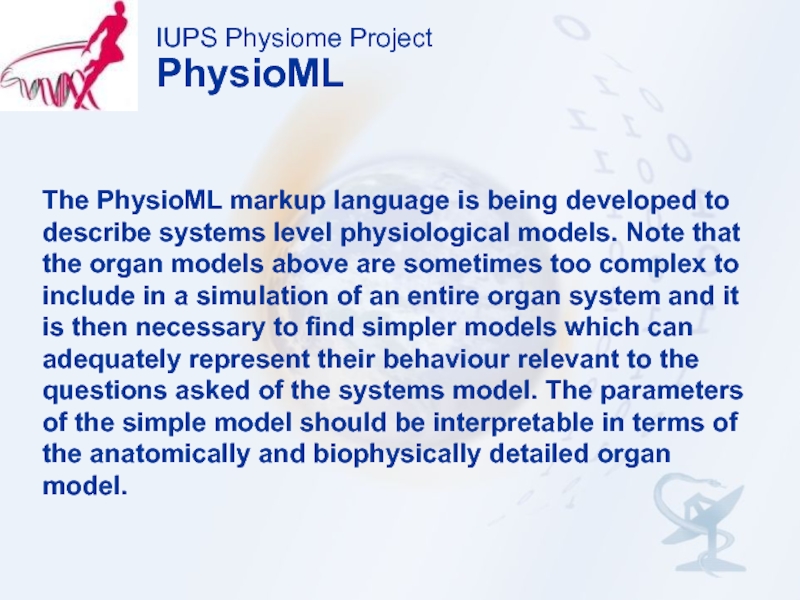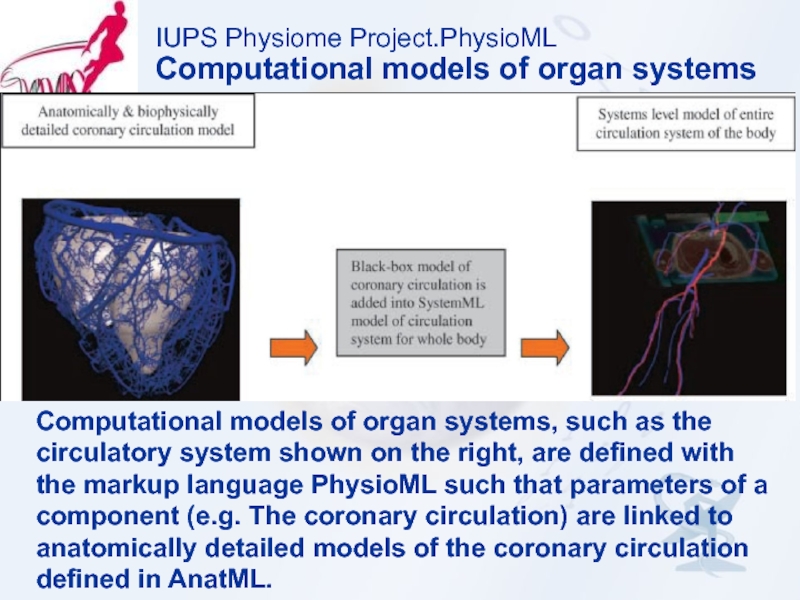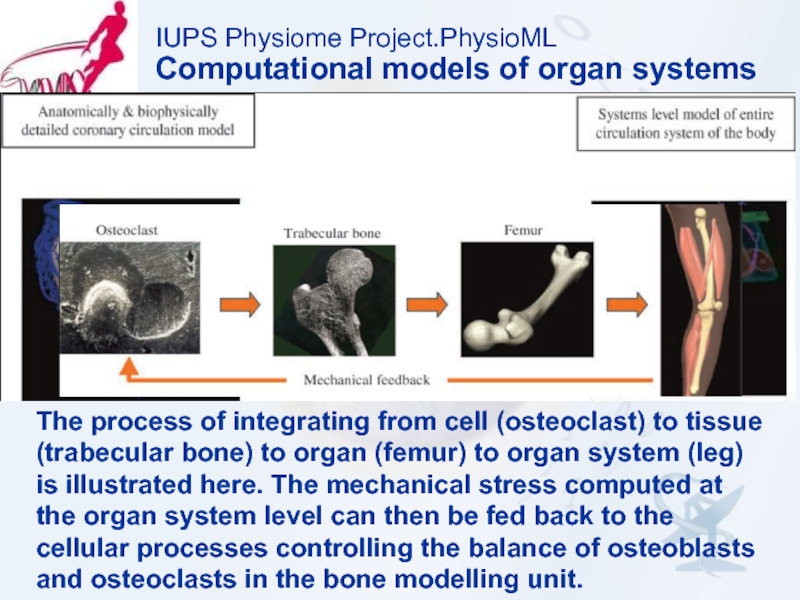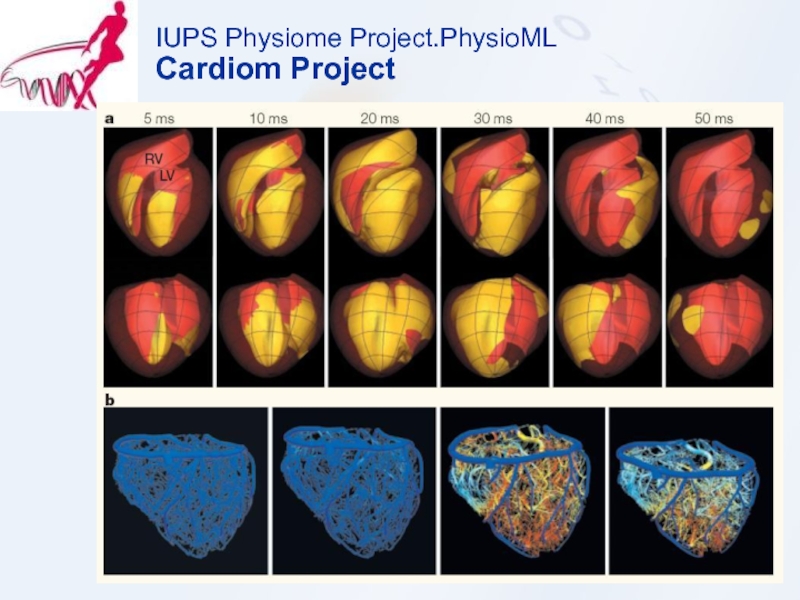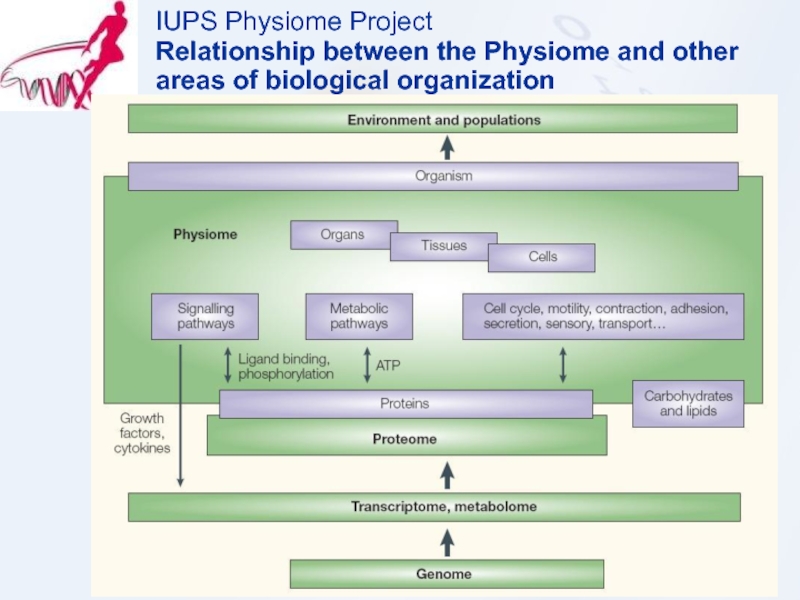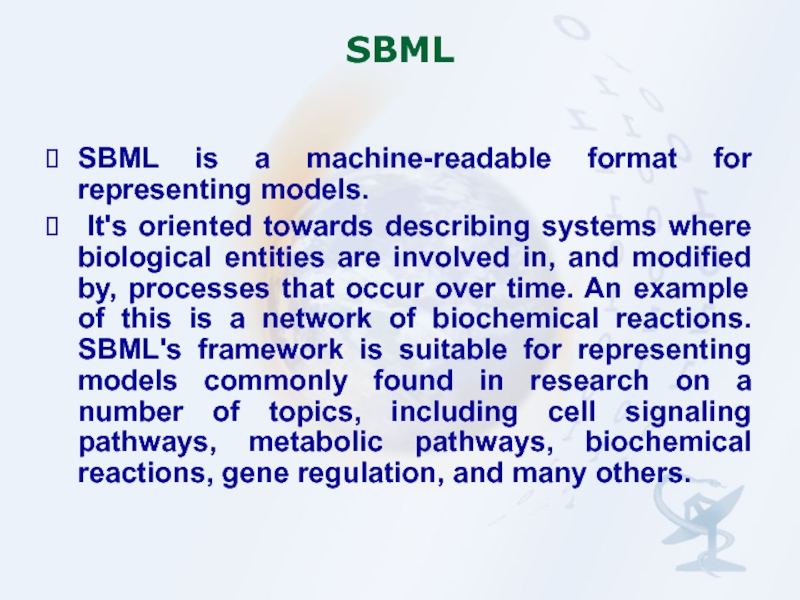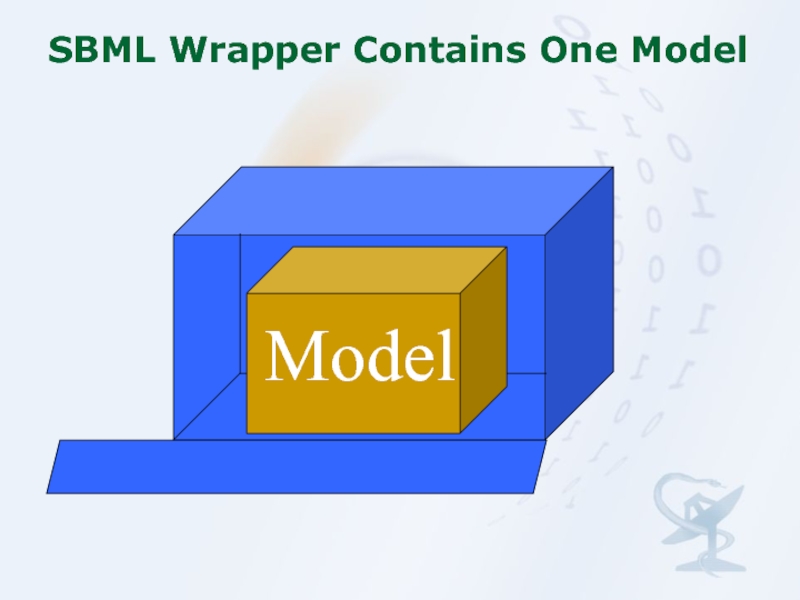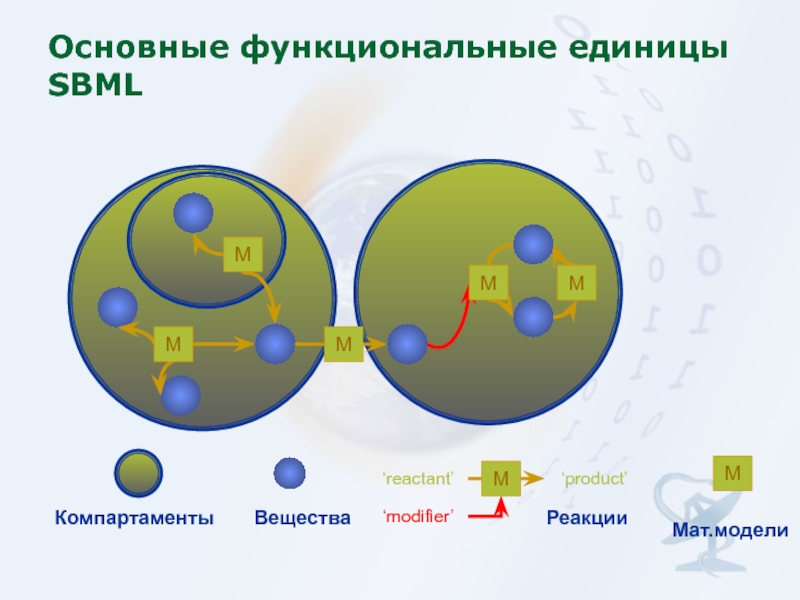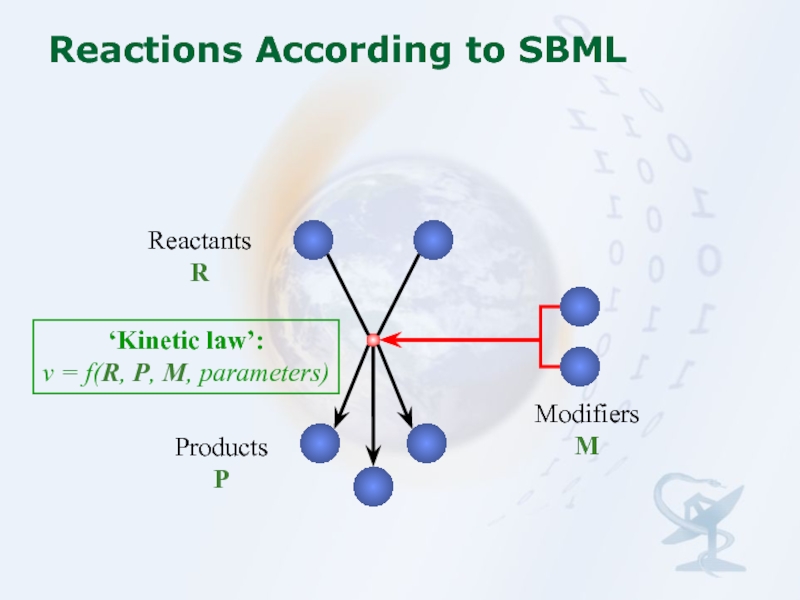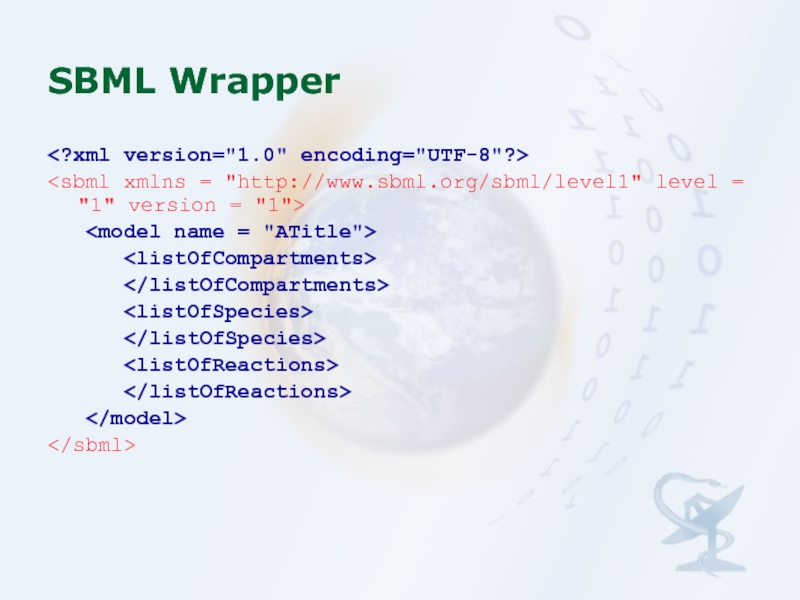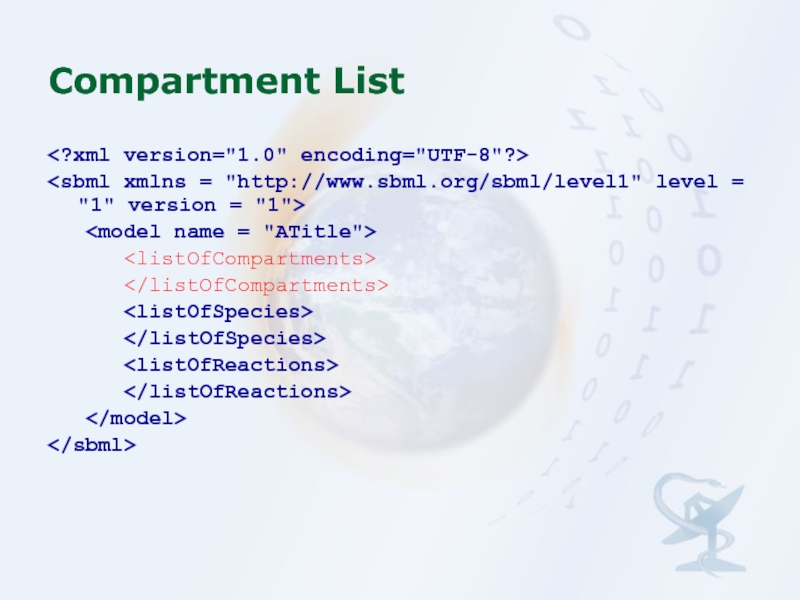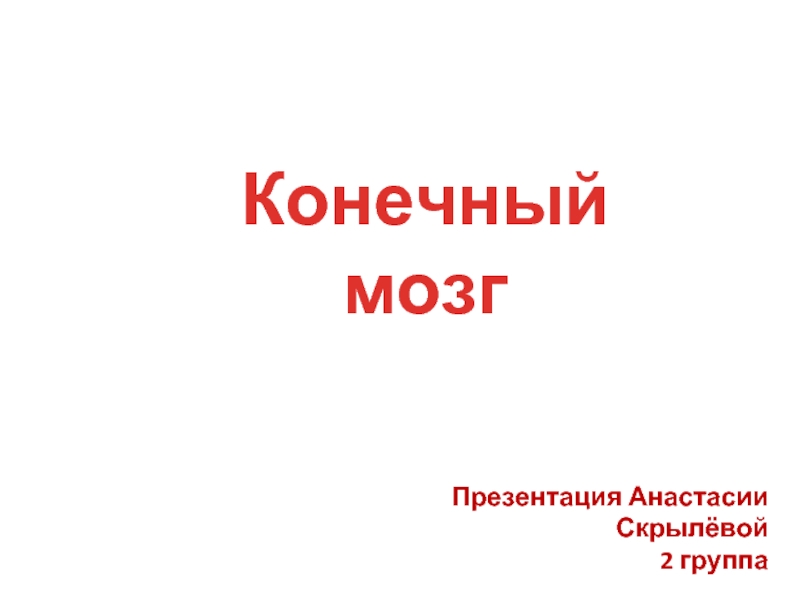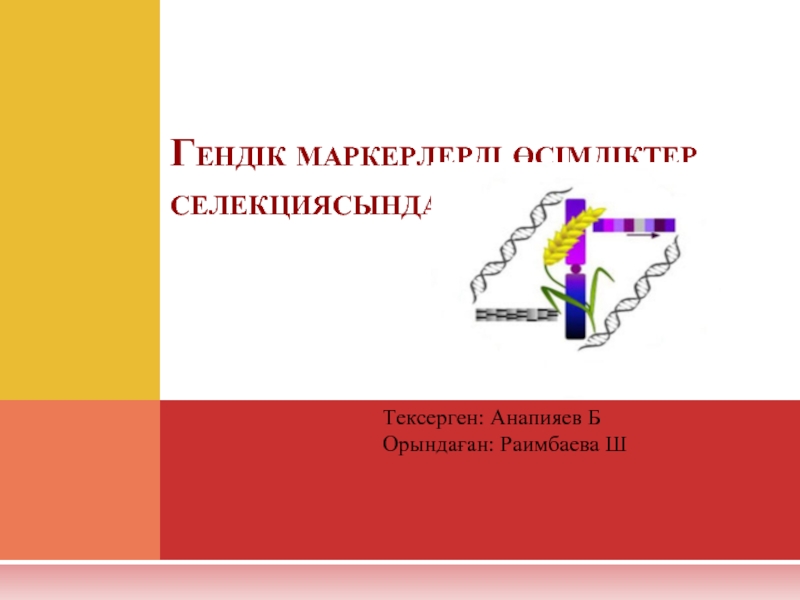2011
- Главная
- Разное
- Дизайн
- Бизнес и предпринимательство
- Аналитика
- Образование
- Развлечения
- Красота и здоровье
- Финансы
- Государство
- Путешествия
- Спорт
- Недвижимость
- Армия
- Графика
- Культурология
- Еда и кулинария
- Лингвистика
- Английский язык
- Астрономия
- Алгебра
- Биология
- География
- Детские презентации
- Информатика
- История
- Литература
- Маркетинг
- Математика
- Медицина
- Менеджмент
- Музыка
- МХК
- Немецкий язык
- ОБЖ
- Обществознание
- Окружающий мир
- Педагогика
- Русский язык
- Технология
- Физика
- Философия
- Химия
- Шаблоны, картинки для презентаций
- Экология
- Экономика
- Юриспруденция
Computational biology презентация
Содержание
- 1. Computational biology
- 2. Computational biology Computational biology is an interdisciplinary
- 3. It encompasses the fields of : Computational
- 4. Mathematical biology aims at the mathematical representation,
- 5. Molecular modeling, which consists of modelling the
- 6. IUPS Physiome Project
- 7. IUPS Physiome Project The Physiome Project
- 8. IUPS Physiome Project
- 9. Physiome Bioinformatics Genes Proteins Biophysical models Constitutive
- 10. Mathematical Models Level 1 models: Molecular models
- 11. Visualization Tools Interrogation of model parameters
- 12. Instrumentation Structural measurements geometry and tissue microstructure
- 13. Physiome Groups BioNoME (UCSD) Biology Network of
- 14. IUPS Physiome Project.PhysioML
- 15. IUPS Physiome Project Spatial and temporal
- 16. IUPS Physiome Project
- 17. What is – ontology? Ontology - the
- 18. Several philosophers - from Aristoteles (4th
- 19. Sowa proposes the following: "The subject
- 20. The use of ontologies in medicine
- 21. Benefits Ontologies can help build more
- 22. IUPS Physiome Project Model ontologies All
- 23. Anatomy Completed or underway: Vent. geom. &
- 24. Mechanics Completed or underway: Material properties -
- 25. Activation Completed or underway: Ionic current models
- 26. IUPS Physiome Project AnatML
- 27. IUPS Physiome Project CellML
- 28. IUPS Physiome Project PhysioML The
- 29. IUPS Physiome Project.PhysioML Computational models of
- 30. IUPS Physiome Project.PhysioML Computational models of
- 31. IUPS Physiome Project.PhysioML Cardiom Project
- 32. IUPS Physiome Project Relationship between the Physiome and other areas of biological organization
- 33. SBML SBML is a machine-readable format for
- 34. SBML Wrapper Contains One Model Model
- 35. How Is an SBML Document Structured?
- 36. ‘reactant’ Основные функциональные единицы SBML
- 37. Reactions According to SBML
- 38. What Does SBML Look Like?
- 39. XML info
- 40. SBML Wrapper
- 41. Model
- 42. Compartment List
- 43. СПАСИБО ЗА ВНИМАНИЕ
Слайд 1Computational biology
Запорожский государственный медицинский университет
Кафедра медицинской и фармацевтической информатики
© Рыжов Алексей
Анатольевич
Слайд 2Computational biology
Computational biology is an interdisciplinary field that applies the techniques
of computer science, applied mathematics and statistics to address biological problems.
The main focus lies on developing mathematical modeling and computational simulation techniques. By these means it addresses scientific research topics with their theoretical and experimental questions without a laboratory.
The main focus lies on developing mathematical modeling and computational simulation techniques. By these means it addresses scientific research topics with their theoretical and experimental questions without a laboratory.
Слайд 3It encompasses the fields of :
Computational biomodeling, a field concerned with
building computer models of biological systems.
Bioinformatics, which applies algorithms and statistical techniques to the interpretation, classification and understanding of biological datasets. These typically consist of large numbers of DNA, RNA, or protein sequences. Sequence alignment is used to assemble the datasets for analysis. Comparisons of homologous sequences, gene finding, and prediction of gene expression are the most common techniques used on assembled datasets; however, analysis of such datasets have many applications throughout all fields of biology.
Bioinformatics, which applies algorithms and statistical techniques to the interpretation, classification and understanding of biological datasets. These typically consist of large numbers of DNA, RNA, or protein sequences. Sequence alignment is used to assemble the datasets for analysis. Comparisons of homologous sequences, gene finding, and prediction of gene expression are the most common techniques used on assembled datasets; however, analysis of such datasets have many applications throughout all fields of biology.
Слайд 4Mathematical biology aims at the mathematical representation, treatment and modeling of
biological processes, using a variety of applied mathematical techniques and tools.
Computational genomics, a field within genomics which studies the genomes of cells and organisms. High-throughput genome sequencing produces lots of data, which requires extensive post-processing (genome assembly) and uses DNA microarray technologies to perform statistical analyses on the genes expressed in individual cell types. This can help find genes of interest for certain diseases or conditions. This field also studies the mathematical foundations of sequencing.
Computational genomics, a field within genomics which studies the genomes of cells and organisms. High-throughput genome sequencing produces lots of data, which requires extensive post-processing (genome assembly) and uses DNA microarray technologies to perform statistical analyses on the genes expressed in individual cell types. This can help find genes of interest for certain diseases or conditions. This field also studies the mathematical foundations of sequencing.
Слайд 5Molecular modeling, which consists of modelling the behaviour of molecules of
biological importance.
Protein structure prediction and structural genomics, which attempt to systematically produce accurate structural models for three-dimensional protein structures that have not been determined experimentally.
Computational biochemistry and biophysics, which make extensive use of structural modeling and simulation methods such as molecular dynamics and Monte Carlo method-inspired Boltzmann sampling methods in an attempt to elucidate the kinetics and thermodynamics of protein functions.
Protein structure prediction and structural genomics, which attempt to systematically produce accurate structural models for three-dimensional protein structures that have not been determined experimentally.
Computational biochemistry and biophysics, which make extensive use of structural modeling and simulation methods such as molecular dynamics and Monte Carlo method-inspired Boltzmann sampling methods in an attempt to elucidate the kinetics and thermodynamics of protein functions.
Слайд 7IUPS Physiome Project
The Physiome Project of the International Union of
Physiological Sciences (IUPS) is attempting to provide a comprehensive framework for modelling the human body using computational methods which can incorporate the biochemistry, biophysics and anatomy of cells, tissues and organs. A major goal of the project is to use computational modelling to analyse integrative biological function in terms of underlying structure and molecular mechanisms.
Слайд 9Physiome Bioinformatics
Genes
Proteins
Biophysical models
Constitutive laws
Organ model
Whole body model
Genome
Protein
Physiology
Structural
Bioeng. Materials
Clinical
Modeling Hierarchies
Databases
Слайд 10Mathematical Models
Level 1 models: Molecular models
Level 2 models: Subcellular Markov
models
Level 3 models: Subcellular ODE models
Level 4 models: Tissue and whole organ continuum models
Level 5 models: Whole body continuum models
Level 6 models: Whole body system models
Level 3 models: Subcellular ODE models
Level 4 models: Tissue and whole organ continuum models
Level 5 models: Whole body continuum models
Level 6 models: Whole body system models
Слайд 11Visualization Tools
Interrogation of model parameters
Animated visualization of computational output
From
molecular level through to the whole body
Web based
Coupled to the computational models in a user-friendly fashion.
Web based
Coupled to the computational models in a user-friendly fashion.
Слайд 12Instrumentation
Structural measurements
geometry and tissue microstructure of organs
present methods too slow and
tedious
Material property measurements
mechanical, electrical, thermal, etc
variety of species
pathological conditions
nonlinear, coupled parameters
Material property measurements
mechanical, electrical, thermal, etc
variety of species
pathological conditions
nonlinear, coupled parameters
Слайд 13Physiome Groups
BioNoME (UCSD)
Biology Network of Modeling Efforts;
Cardiome Project
the model
and most active group
Microcirculatory Physiome Project
Endotheliome Project
Pulmonary Physiome
Microcirculatory Physiome Project
Endotheliome Project
Pulmonary Physiome
Слайд 15IUPS Physiome Project
Spatial and temporal scales
The wide range of spatial
and temporal scales encompassed by the Physiome Project are shown in slide. It should be emphasized that no one model would encompass the 109 dynamic range of spatial scales (from the 1-nm pore size of an ion channel to the 1-m scale of the human body) or 1015 dynamic range of temporal scales.
Markup languages (PhysioML, AnatML, TissueML, CellML) are defined for each spatial level as indicated here. The types of mathematical model appropriate to each spatial scale are also indicated.
Markup languages (PhysioML, AnatML, TissueML, CellML) are defined for each spatial level as indicated here. The types of mathematical model appropriate to each spatial scale are also indicated.
Слайд 17What is – ontology?
Ontology - the "science of being" - typically
has different meanings in different contexts.
Webster's Dictionary defines ontology as:
a branch of metaphysics relating to the nature and relations of being
a particular theory about the nature of being and the kinds of existence
Webster's Dictionary defines ontology as:
a branch of metaphysics relating to the nature and relations of being
a particular theory about the nature of being and the kinds of existence
Слайд 18
Several philosophers - from Aristoteles (4th Century BC) to Leibniz (1646-1716),
and more recently the 19th Century major ontologists like Bolzano, Brentano, Husserl and Frege - have provided criteria for distinguishing between different kind of objects (a.g. concrete vs. abstract) and the relations between them.
In the late 20th Century, Artificial Intelligence (AI) adopted the term and began using it in the sense of a "specification of a conceptualization" in the context of knowledge and data sharing (Gruber).
In the late 20th Century, Artificial Intelligence (AI) adopted the term and began using it in the sense of a "specification of a conceptualization" in the context of knowledge and data sharing (Gruber).
Слайд 19
Sowa proposes the following: "The subject of ontology is the study
of the categories of things that exist or may exist in some domain.
The product of such a study, called an ontology, is a catalog of the types of things that are assumed to exist in a domain of interest D from the perspective of a person who uses a language L for the purpose of talking about D."
The product of such a study, called an ontology, is a catalog of the types of things that are assumed to exist in a domain of interest D from the perspective of a person who uses a language L for the purpose of talking about D."
Слайд 20
The use of ontologies in medicine is mainly focussed on the
representation and (re-)organization of medical terminologies.
Physicians developed their own specialized languages and lexicons to help them store and communicate general medical knowledge and patient-related information efficiently.
Such terminologies, optimized for human processing, are characterized by a significant amount of implicit knowledge.
Medical information systems, on the other hand, need to be able to communicate complex and detailed medical concepts (possibly expressed in different languages) unambiguously. This is obviously a difficult task and requires a profound analysis of the structure and the concepts of medical terminologies. But it can be achieved by constructing medical domain ontologies for representing medical terminology systems.
Physicians developed their own specialized languages and lexicons to help them store and communicate general medical knowledge and patient-related information efficiently.
Such terminologies, optimized for human processing, are characterized by a significant amount of implicit knowledge.
Medical information systems, on the other hand, need to be able to communicate complex and detailed medical concepts (possibly expressed in different languages) unambiguously. This is obviously a difficult task and requires a profound analysis of the structure and the concepts of medical terminologies. But it can be achieved by constructing medical domain ontologies for representing medical terminology systems.
Слайд 21Benefits
Ontologies can help build more powerful and more interoperable information
systems in healthcare.
Ontologies can support the need of the healthcare process to transmit, re-use and share patient data.
Ontologies can also provide semantic-based criteria to support different statistical aggregations for different purposes.
Possibly the most significant benefit that ontologies may bring to healthcare systems is their ability to support the indispensible integration of knowledge and data.
On the negative side:
Some remain sceptical about the impact that ontologies may have on the design and maintenance of real-world healthcare information systems.
Ontologies can support the need of the healthcare process to transmit, re-use and share patient data.
Ontologies can also provide semantic-based criteria to support different statistical aggregations for different purposes.
Possibly the most significant benefit that ontologies may bring to healthcare systems is their ability to support the indispensible integration of knowledge and data.
On the negative side:
Some remain sceptical about the impact that ontologies may have on the design and maintenance of real-world healthcare information systems.
Слайд 22IUPS Physiome Project
Model ontologies
All organ systems have now been defined.
See
www.bioeng.auckland.ac.nz/physiome/physiome.php).
The web pages setup to
display an ontology tree for
human anatomy.
Слайд 23Anatomy
Completed or underway:
Vent. geom. & fibre-sheet structure for dog
Vent. geom. &
fibre-sheets for rabbit
Coronary anatomy for pig
Atrial geometry & structure for pig
Cardiac valve structure
Automated measurement rig
Needed soon:
Geom. & fibre-sheet structure for pig, human
Geom. & fibre-sheet structure for hypertrophy etc
Coronary anatomy for pig
Atrial geometry & structure for pig
Cardiac valve structure
Automated measurement rig
Needed soon:
Geom. & fibre-sheet structure for pig, human
Geom. & fibre-sheet structure for hypertrophy etc
Слайд 24Mechanics
Completed or underway:
Material properties -
biaxial tests on dog myocardium (AU)
shear
testing of pig myocardium (AU)
torsion testing of rabbit pap. muscle (JHU)
ECM structure (UCSD, Columbia, AU, JHU)
Functional studies on gene targetted mice (UCSD)
Infarct modelling (UCSD, Columbia, AU)
Ventricular aneurysm (UCSF)
Acute ischaemia (UCSD, UWash)
Needed soon:
Microstructure & mechanical properties of cytoskeleton & ECM
torsion testing of rabbit pap. muscle (JHU)
ECM structure (UCSD, Columbia, AU, JHU)
Functional studies on gene targetted mice (UCSD)
Infarct modelling (UCSD, Columbia, AU)
Ventricular aneurysm (UCSF)
Acute ischaemia (UCSD, UWash)
Needed soon:
Microstructure & mechanical properties of cytoskeleton & ECM
Слайд 25Activation
Completed or underway:
Ionic current models
Spatial distribution of ion channels
SA, atrial, AV,
HIS, Purkinje
Reentrant arrhythmias
Defibrillation studies
Heart failure
Mutations
EC coupling
CellML
Needed soon:
Spatial distribution of gap junctions
Drugs -> models -> clinically observable effects
Mutations
Expression profiling in acquired heart disease
Reentrant arrhythmias
Defibrillation studies
Heart failure
Mutations
EC coupling
CellML
Needed soon:
Spatial distribution of gap junctions
Drugs -> models -> clinically observable effects
Mutations
Expression profiling in acquired heart disease
Слайд 26IUPS Physiome Project
AnatML
This markup language is being developed to describe
anatomy. AnatML files have now been created for many organs and systems in the body and an ontology for this “top down” aspect of the Physiome is accessible via the web at
www.bioeng.auckland.ac.nz/physiome/physiome.php.
Слайд 27IUPS Physiome Project
CellML
This markup language is being developed to deal
with models covering all aspects of cellular function. A number of electrophysiological, metabolic and signal transduction pathway models have already been developed in CellML format and are currently available from the website www.cellml.org. This list will be extended to include many more models covering all cell types and all aspects of cell function as these models are published.
Слайд 28IUPS Physiome Project
PhysioML
The PhysioML markup language is being developed to
describe systems level physiological models. Note that the organ models above are sometimes too complex to include in a simulation of an entire organ system and it is then necessary to find simpler models which can adequately represent their behaviour relevant to the questions asked of the systems model. The parameters of the simple model should be interpretable in terms of the anatomically and biophysically detailed organ model.
Слайд 29IUPS Physiome Project.PhysioML
Computational models of organ systems
Computational models of organ
systems, such as the
circulatory system shown on the right, are defined with the markup language PhysioML such that parameters of a component (e.g. The coronary circulation) are linked to anatomically detailed models of the coronary circulation defined in AnatML.
circulatory system shown on the right, are defined with the markup language PhysioML such that parameters of a component (e.g. The coronary circulation) are linked to anatomically detailed models of the coronary circulation defined in AnatML.
Слайд 30IUPS Physiome Project.PhysioML
Computational models of organ systems
The process of integrating
from cell (osteoclast) to tissue (trabecular bone) to organ (femur) to organ system (leg) is illustrated here. The mechanical stress computed at the organ system level can then be fed back to the cellular processes controlling the balance of osteoblasts and osteoclasts in the bone modelling unit.
Слайд 32IUPS Physiome Project
Relationship between the Physiome and other areas of biological
organization
Слайд 33SBML
SBML is a machine-readable format for representing models.
It's oriented towards
describing systems where biological entities are involved in, and modified by, processes that occur over time. An example of this is a network of biochemical reactions. SBML's framework is suitable for representing models commonly found in research on a number of topics, including cell signaling pathways, metabolic pathways, biochemical reactions, gene regulation, and many others.
